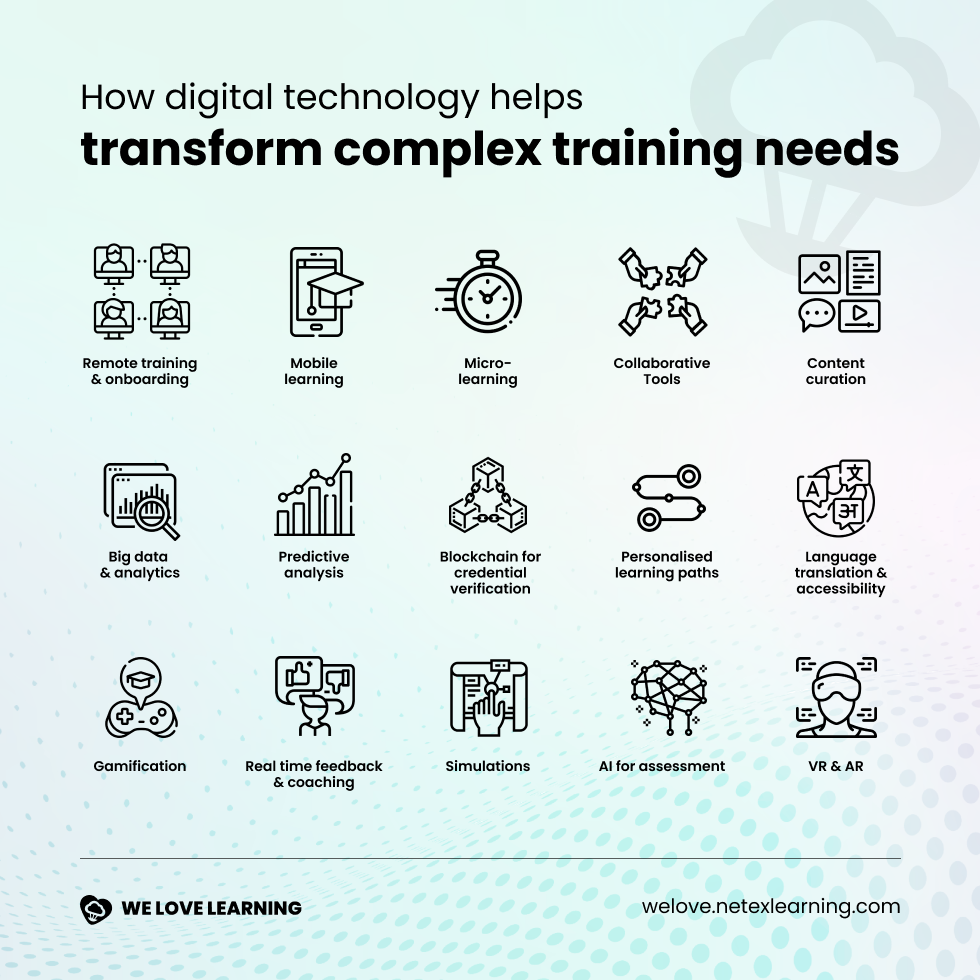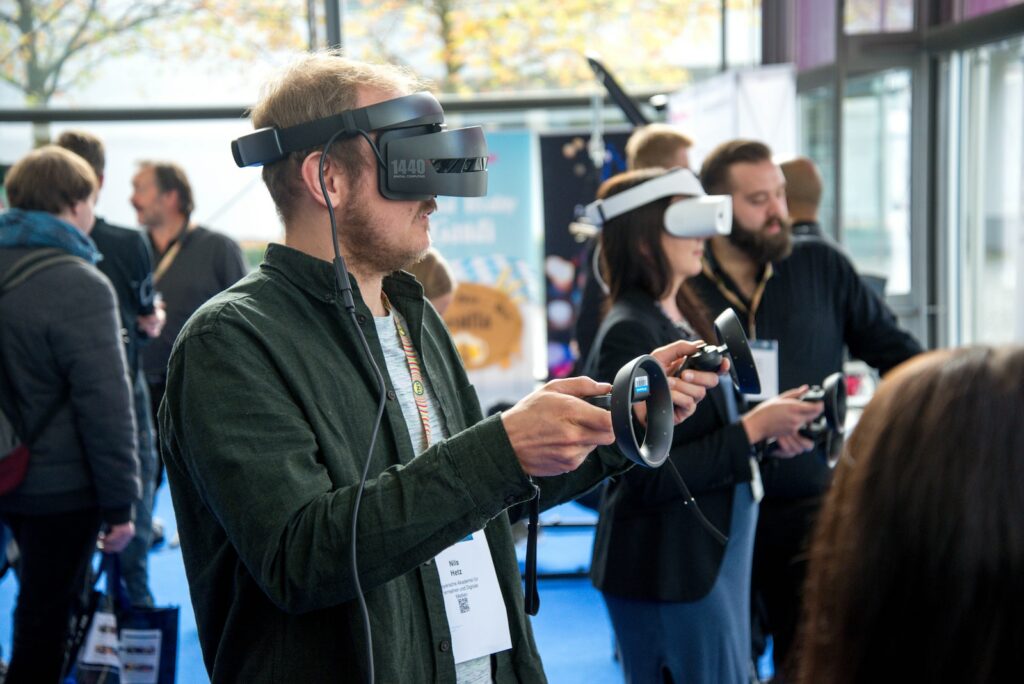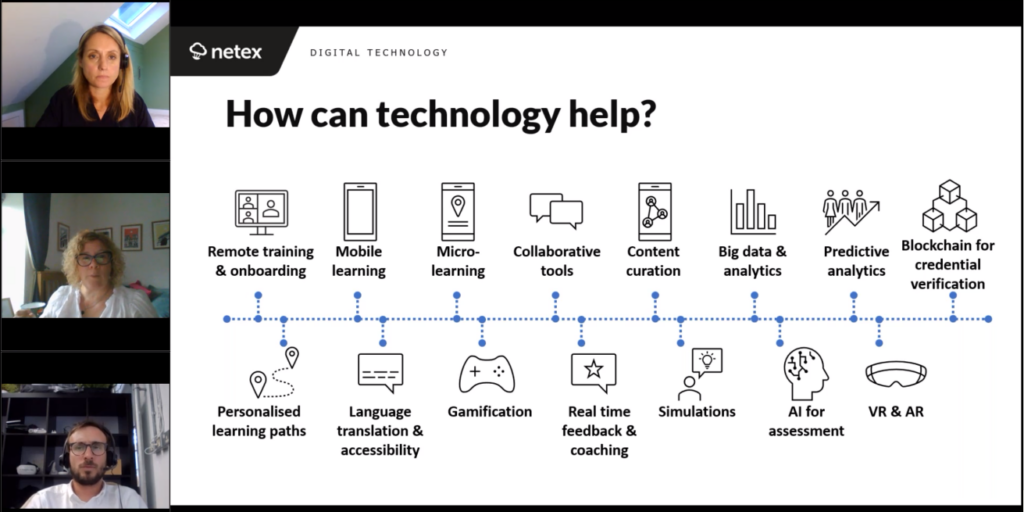Share
Digital training has come a long way in recent years. It used to be that you heard the term ‘e-learning’ and you’d think of compliance training and the hours of slides that you had to click through. But that’s changing now. Technology has come on leaps and bounds and the options available to create digital training have increased immensely (as can be seen in the image below).
The effect of this is not just that digital training has become more engaging and effective, but that the types of training it can support has increased too. It’s now not just used for compliance training, but it’s suitable for more complex training needs too. Whether that is specialised training needs, which require highly technical knowledge and a commitment of time; training that would traditionally be taught face-to-face, such as power skills, which deal with human interaction, or a complex training solution, that has learners situated across the globe, covering many topics, and requires regular updates.
In this article, we’ll explore the benefits you can gain from using technology and share some examples which will illustrate how it can work in practice.

The benefits of using technology to transform complex training needs
It’s understandable that people would be hesitant at the idea of replacing practical, face-to-face training with different technologies. Surely, you need the practical experience, and the necessary human interaction? And you do; in fact, we’re not saying those elements aren’t important, but we know that there are many benefits of bringing technologies into the training solution, not as a replacement, but as an enhancer. What are these benefits?
Decreases health and safety risks
Using virtual or digital versions of equipment is a great way to introduce someone to a piece of complex and potentially dangerous piece of kit. It is a lot safer; they can’t injure themselves, and they can’t break anything – they can simply use the digital version in a safe environment to help familiarise themselves before they use the real thing.

When it comes to training such as power skills, technology can provide a psychologically safe space in which to practice and fail. As you’ll see in our VR example below, the learners can make mistakes, but without any of the potential risks, allowing them to build their confidence and knowledge, which they can then take into the real workspace.
Allows for multiple users
When demonstrating a piece of equipment in a class, there is often only one piece available. Having digital versions means that multiple people can use it at the same time, ensuring that everyone has the opportunity, without the added pressure of only having access for a limited time.
Available 24/7
Digital technology is easily accessible 24/7. This means learners can use and access the technology as much as they like until they feel confident to take their newly acquired skills into the workplace.
Durable
This is a benefit that really stands out when you’re learning how to use pieces of equipment. Digital versions don’t break, they don’t need repairs and they don’t wear and tear.
It doesn’t have to be an ‘either/or’ decision when it comes to using technology. It can be used as part of a blended learning solution, alongside practical and face-to-face teachings, and be adopted to help enhance the learner’s experience. Imagine how beneficial it would be if learners were introduced to a new concept or piece of equipment, but then could go away and practise through digital technology as often as he or she likes – this would help improve their confidence dramatically.
But what does this adoption look like in practice? Here are two different examples to illustrate how technology can be used to support complex training needs. The first is an example which doesn’t just draw on one type of technology, but uses a combination to really bring the solution to light. The second is an example of how VR is transforming communication skills training.
An example: General Mills and Häagen-Dazs
General Mills is a big name in the food and drink industry, and they wanted to provide Häagen-Dazs, one of their brands, with a new and improved training solution. Their face-to-face offering was failing. Their employees were facing tedious and difficult training experiences that left them lacking in the knowledge and insights that would improve customer experience. They were generally feeling unmotivated, and this was felt across all their stores, globally.
To combat this, General Mills decided to turn to digital training solutions to try and get their employees back on board. It had complex requirements: it needed to reach their global learners, cover a range of topics that were easily accessible and would quickly and efficiently teach them what they needed, as well as be a portal for future communications around new products and training. So, through a combination of different technologies, we created a solution that boosted their staff’s knowledge and abilities.
What technology did we provide?
As the majority of the staff were working on the shop floor, the training needed to be mobile-first, so we provided a mobile app. Training was easily accessible through the mobile, meaning they could access it anywhere, any time. To complement this app, the training was designed as micro-learning. We knew the learners wouldn’t have long periods of time to sit (or stand), so learning needed to be digestible, as well as easy to dip in and out of.
To engage the learners, we used different approaches. We ensured that all the required languages were available, so they could easily understand the content; videos were used to help bring the learning to life, and add variety; gamification elements, such as badges and awards, were used to motivate learners and indicate their progress; and we integrated social learning elements as well, allowing the learners to comment on the learning.

Lastly, Learning Cloud, our learning management system, hosted all the content. Learning management systems aren’t exactly new news in the digital training world, but the quality and offerings of one can make a huge difference to the learning. Our user experience drew the Häagen-Dazs learners in, and made sure training was easy to navigate and made the whole experience easy and appealing. It was also used to communicate with the learners; for example, they were notified about new products so they could keep up to date with them, allowing them to easily stay in the know.
What’s the takeaway from this example? Don’t think you just have to choose one type of technology. It’s often a combination of many different types that truly transforms the training.
A Virtual Reality (VR) example: Bodyswaps
But how are more advanced, complex pieces of technology being used? There is a growing curiosity about how VR can be used in training. It is being used very effectively to train on complicated bits of equipment, or even the human body, but, and this may be surprising, it is also being used for power skills, and to great effect.
One such example is some training for The Royal College of Medicine, which helped their staff learn and practice how to cope with a variety of communication challenges, like angry patients, as well as people with mental health issues.
This training was developed by a partner of ours, Bodyswaps. Their concept is to use VR sets, which puts the learner in a fictional space where they can talk to a character, to allow them to practice their communication skills. But it doesn’t just stop there. They can also swap places with the character, and be on the receiving end of their practice, so they can experience first-hand how they did, which is a unique learning experience you wouldn’t get normally.
The learner also receives detailed feedback on different communication areas relevant to the topic, but one of the great benefits that came out of this example is that learners can clearly see themselves develop. Through the use of numerous attempts, personalised feedback and the ability to witness their own performance, they are able to recognise how far they have come, as well as see areas where they needed to improve.
This example illustrates how technology can be used in truly imaginative ways. This is a ‘thinking outside the box’ example, and is showing the effective ways technology can be used to help prepare learners for important and critical areas of their roles.
Watch ‘How digital training is transforming complex training needs’ webinar recording
If you are interested to know more about the topic, don’t miss the recording of the webinar that we held at Leeds Digital Festival.
In this session, we helped our attendees identify how to address new complex training needs through the various digital learning technologies available and when best to use them. To help bring them to life, we shared some case study examples, showcasing how virtual and augmented reality, and other tools, can help to accelerate their training programmes past basic mandatory requirements.
Share


